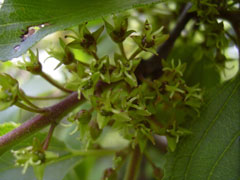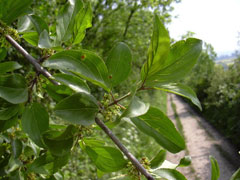 |
|
(c) 2010 Ken Fern & Plants For A Future |
 |
| (c) 2010 Ken Fern & Plants For A Future |
Translate this page:
Summary
Physical Characteristics

 Rhamnus cathartica is a deciduous Shrub growing to 6 m (19ft) by 3 m (9ft).
Rhamnus cathartica is a deciduous Shrub growing to 6 m (19ft) by 3 m (9ft).
See above for USDA hardiness. It is hardy to UK zone 3 and is not frost tender. It is in flower from May to June, and the seeds ripen in October. The species is dioecious (individual flowers are either male or female, but only one sex is to be found on any one plant so both male and female plants must be grown if seed is required). and is pollinated by Insects. The plant is not self-fertile.
It is noted for attracting wildlife.
Suitable for: light (sandy), medium (loamy) and heavy (clay) soils. Suitable pH: mildly acid, neutral and basic (mildly alkaline) soils and can grow in very alkaline soils.
It can grow in semi-shade (light woodland) or no shade. It prefers dry or moist soil.
UK Hardiness Map
US Hardiness Map
Synonyms
Cervispina cathartica (L.) Moench
Plant Habitats
Woodland Garden Sunny Edge; Dappled Shade; Shady Edge; Hedge;
Edible Uses
References More on Edible Uses
Medicinal Uses
Plants For A Future can not take any responsibility for any adverse effects from the use of plants. Always seek advice from a professional before using a plant medicinally.
Cathartic Depurative Diuretic Laxative Purgative
Both the bark and the fruit of common buckthorn have been used for their purgative effect upon the body, however they can be rather violent in their action and so are rarely used in human medicines[244]. The berries, harvested when fully ripe, are cathartic, depurative, diuretic, laxative and violently purgative[1, 4, 9, 19, 46, 61, 218, 238]. About 8 - 15 of the mature fruits, chewed before breakfast, are a strong and effective laxative for adults, they should not be used by children[9]. An infusion of the not quite mature fruits is gentler in its action[9]. Use with caution, in large doses the fruit can cause vomiting and violent diarrhoea[9, 21]. The German Commission E Monographs, a therapeutic guide to herbal medicine, approve Rhamnus cathartica for constipation (see [302] for critics of commission E).
References More on Medicinal Uses
The Bookshop: Edible Plant Books
Our Latest books on Perennial Plants For Food Forests and Permaculture Gardens in paperback or digital formats.

Edible Tropical Plants
Food Forest Plants for Hotter Conditions: 250+ Plants For Tropical Food Forests & Permaculture Gardens.
More

Edible Temperate Plants
Plants for Your Food Forest: 500 Plants for Temperate Food Forests & Permaculture Gardens.
More

More Books
PFAF have eight books available in paperback and digital formats. Browse the shop for more information.
Shop Now
Other Uses
Dye Hedge Hedge Wood
A green dye is obtained from the immature fruit[46, 57, 103, 115, 171]. Mixed with gum arabic and limewater, it makes a green pigment used in watercolour painting[238]. Yellow, orange and brownish dyes can also be obtained[100]. The colours are rich but fugitive[4]. A yellow dye is obtained from the bark[61, 100, 115]. It has been used to colour paper and maps[238]. Often grown as an informal hedge, it is also amenable to trimming[21, 186, 200]. Wood - hard, handsome with a marble-like grain. Used for small turnery[46, 61, 74].
Special Uses
Attracts Wildlife Hedge Hedge
References More on Other Uses
Cultivation details
Succeeds in any reasonably good soil[11]. Prefers a dry or moist calcareous soil[1, 4, 9] in sun or light dappled shade[200]. This species is hardy to at least -15°c[238]. Plants regenerate well after cutting or burning but young plants are rather prone to frost damage when grown in an exposed position[186]. Plants are resistant to cattle grazing but young plants can be damaged by rabbits[186]. Plants have a very shallow root system[186]. This species often bears the aecidospore stage of 'crown rust' of oats so it should not be grown near cereals[1, 186]. The species in this genus are notably resistant to honey fungus[200]. A good bee plant[4, 108] and a main food plant for the brimstone butterfly[186]. Dioecious. Male and female plants must be grown if seed is required.
References Carbon Farming Information and Carbon Sequestration Information
Temperature Converter
Type a value in the Celsius field to convert the value to Fahrenheit:
Fahrenheit:
The PFAF Bookshop
Plants For A Future have a number of books available in paperback and digital form. Book titles include Edible Plants, Edible Perennials, Edible Trees,Edible Shrubs, Woodland Gardening, and Temperate Food Forest Plants. Our new book is Food Forest Plants For Hotter Conditions (Tropical and Sub-Tropical).
Shop Now
Plant Propagation
Seed - best sown as soon as it is ripe in the autumn in a cold frame. Stored seed will require 1 - 2 months stratification at 5°c and should be sown as early in the year as possible in a cold frame[200]. Prick out the seedlings into individual pots when they are large enough to handle, and grow them on in the greenhouse or cold frame for their first winter. Plant them out in late spring or early summer of the following year. Cuttings of half-ripe wood, July/August in a frame[113]. Cuttings of mature wood of the current year's growth, autumn in a frame. Layering in early spring[4].
Other Names
If available other names are mentioned here
Native Plant Search
Search over 900 plants ideal for food forests and permaculture gardens. Filter to search native plants to your area. The plants selected are the plants in our book 'Plants For Your Food Forest: 500 Plants for Temperate Food Forests and Permaculture Gardens, as well as plants chosen for our forthcoming related books for Tropical/Hot Wet Climates and Mediterranean/Hot Dry Climates. Native Plant Search
Found In
Countries where the plant has been found are listed here if the information is available
Weed Potential
Right plant wrong place. We are currently updating this section.
Please note that a plant may be invasive in one area but may not in your area so it’s worth checking.
Conservation Status
IUCN Red List of Threatened Plants Status :

Growth: S = slow M = medium F = fast. Soil: L = light (sandy) M = medium H = heavy (clay). pH: A = acid N = neutral B = basic (alkaline). Shade: F = full shade S = semi-shade N = no shade. Moisture: D = dry M = Moist We = wet Wa = water.

Expert comment
Author
L.
Botanical References
1117200
Links / References
For a list of references used on this page please go here
Readers comment